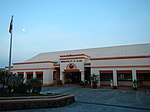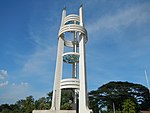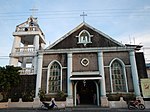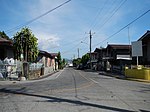Bagac
Bagac | |
|---|---|
| Municipality of Bagac | |
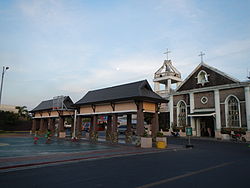 Municipal Plaza | |
 Map of Bataan with Bagac highlighted | |
Location in the Philippines | |
| Coordinates: 14°35′42″N 120°23′31″E / 14.595058°N 120.391831°E | |
| Country | Philippines |
| Region | Central Luzon |
| Province | Bataan |
| District | 3rd district |
| Founded | 1866 |
| Barangays | 14 (see Barangays) |
| Government | |
| • Type | Sangguniang Bayan |
| • mayor of Bagac[*] | Rommel V. del Rosario |
| • Vice Mayor | Ron Michael Alexis R. del Rosario |
| • Representative | Jose Enrique S. Garcia III |
| • Municipal Council | Members |
| • Electorate | 24,423 voters (2022) |
| Area | |
• Total | 231.20 km2 (89.27 sq mi) |
| Elevation | 74 m (243 ft) |
| Highest elevation | 379 m (1,243 ft) |
| Lowest elevation | 0 m (0 ft) |
| Population (2020 census)[3] | |
• Total | 31,365 |
| • Density | 140/km2 (350/sq mi) |
| • Households | 7,583 |
| Economy | |
| • Income class | 3rd municipal income class |
| • Poverty incidence | 12.46 |
| • Revenue | ₱ 156.3 million (2020) |
| • Assets | ₱ 527.9 million (2020) |
| • Expenditure | ₱ 168.2 million (2020) |
| • Liabilities | ₱ 198.1 million (2020) |
| Service provider | |
| • Electricity | Peninsula Electric Cooperative (PENELCO) |
| Time zone | UTC+8 (PST) |
| ZIP code | 2107 |
| PSGC | |
| IDD : area code | +63 (0)47 |
| Native languages | Mariveleño Tagalog |
Bagac, officially the Municipality of Bagac (Tagalog: Bayan ng Bagac), is a 3rd class municipality in the province of Bataan, Philippines. It covers an area of 231.20 square kilometres (89.27 sq mi), making it the largest municipality in Bataan. However, according to the 2020 census, it has a population of 31,365 people, making it the least populated municipality in the province.[3]
It is 27 kilometres (17 mi) from Balanga and 151 kilometres (94 mi) from Manila.
Geography
[edit]According to the Philippine Statistics Authority,[5] the municipality has a land area of 231.20 square kilometres (89.27 sq mi) [6] constituting 16.84% of the 1,372.98-square-kilometre- (530.11 sq mi) total area of Bataan.
Bagac borders Balanga (the provincial capital) to the north, Orion and Limay to the east, Mariveles to the south, and Morong and the South China Sea to the west.
Barangays
[edit]Bagac is politically subdivided into 14 barangays.[7] Each barangay consists of puroks and some have sitios.
| PSGC | Barangay | Population | ±% p.a. | |||
|---|---|---|---|---|---|---|
| 2020[3] | 2010[8] | |||||
| 030802016 | Atilano L. Ricardo | 7.8% | 2,447 | 2,224 | 0.96% | |
| 030802001 | Bagumbayan (Poblacion) | 6.3% | 1,978 | 1,766 | 1.14% | |
| 030802002 | Banawang | 8.9% | 2,784 | 2,690 | 0.34% | |
| 030802003 | Binuangan | 2.0% | 613 | 609 | 0.07% | |
| 030802004 | Binukawan | 7.5% | 2,356 | 2,293 | 0.27% | |
| 030802006 | Ibaba | 5.4% | 1,689 | 1,760 | −0.41% | |
| 030802007 | Ibis | 5.3% | 1,660 | 1,407 | 1.67% | |
| 030802008 | Pag‑asa (Wawa‑Sibacan) | 10.4% | 3,271 | 3,456 | −0.55% | |
| 030802009 | Parang | 10.4% | 3,248 | 3,073 | 0.56% | |
| 030802010 | Paysawan | 2.3% | 731 | 680 | 0.73% | |
| 030802012 | Quinawan | 1.8% | 574 | 553 | 0.37% | |
| 030802013 | San Antonio | 4.6% | 1,445 | 1,295 | 1.10% | |
| 030802014 | Saysain | 9.1% | 2,859 | 2,539 | 1.19% | |
| 030802015 | Tabing‑Ilog (Poblacion) | 4.1% | 1,281 | 1,223 | 0.46% | |
| Total | 31,365 | 25,568 | 2.06% | |||
Climate
[edit]| Climate data for Bagac | |||||||||||||
|---|---|---|---|---|---|---|---|---|---|---|---|---|---|
| Month | Jan | Feb | Mar | Apr | May | Jun | Jul | Aug | Sep | Oct | Nov | Dec | Year |
| Mean daily maximum °C (°F) | 30.6 (87.1) |
31.4 (88.5) |
33.0 (91.4) |
34.2 (93.6) |
33.6 (92.5) |
31.8 (89.2) |
30.8 (87.4) |
30.1 (86.2) |
30.7 (87.3) |
31.3 (88.3) |
31.2 (88.2) |
30.6 (87.1) |
31.6 (88.9) |
| Daily mean °C (°F) | 26.3 (79.3) |
26.6 (79.9) |
28.0 (82.4) |
29.2 (84.6) |
29.2 (84.6) |
28.2 (82.8) |
27.4 (81.3) |
27.0 (80.6) |
27.3 (81.1) |
27.5 (81.5) |
27.3 (81.1) |
26.5 (79.7) |
27.5 (81.6) |
| Mean daily minimum °C (°F) | 22.0 (71.6) |
21.9 (71.4) |
23.0 (73.4) |
24.3 (75.7) |
24.9 (76.8) |
24.6 (76.3) |
24.1 (75.4) |
24.0 (75.2) |
23.9 (75.0) |
23.8 (74.8) |
23.4 (74.1) |
22.5 (72.5) |
23.5 (74.4) |
| Average rainfall mm (inches) | 7 (0.3) |
7 (0.3) |
6 (0.2) |
22 (0.9) |
210 (8.3) |
409 (16.1) |
697 (27.4) |
930 (36.6) |
456 (18.0) |
232 (9.1) |
102 (4.0) |
33 (1.3) |
3,111 (122.5) |
| Source: Climate-Data.org[9] | |||||||||||||
Bagac has a tropical monsoon climate (Am) with little to no rainfall from December to April and heavy to extremely heavy rainfall from May to November.
Demographics
[edit]
|
|
| ||||||||||||||||||||||||||||||||||||||||||||||||||||||
| Source: Philippine Statistics Authority[10][8][11][12] | ||||||||||||||||||||||||||||||||||||||||||||||||||||||||
In the 2020 census, Bagac had a population of 31,365.[3] The population density was 140 inhabitants per square kilometre (360/sq mi).
Economy
[edit]Poverty incidence of Bagac
5
10
15
20
2006
15.70 2009
19.68 2012
9.37 2015
11.17 2018
6.07 2021
12.46 Source: Philippine Statistics Authority[13][14][15][16][17][18][19][20] |
Tourism
[edit]- Bagac Friendship Tower — The monument, symbolizing the renewed friendship between Japan and the Philippines after the events of World War II, was erected by Risshō Kōsei Kai, a Japanese Buddhist organization. The tower was inaugurated on April 8, 1975, and is located about 200 m (660 ft) from where the Bataan Death March started. The 27-metre-high (89 ft) tower is composed of three pillars interconnected by several multi-layer rings. It located at the junction of the Gov. Linao National Road and the road to the Bagac town proper.[21]
- Las Casas Filipinas de Acuzar — a heritage park built by José "Gerry" Acuzar, owner of the New San Jose Builders and antique collector. Inside this heritage park is a collection of Spanish Colonial buildings and stone houses (bahay na bato in Tagalog), planned to resemble a settlement reminiscent of the period. These houses were carefully transplanted from different parts of the Philippines and rehabilitated to their former splendor.
Gallery
[edit]-
Municipal hall
-
Heritage Houses, Las Casas Filipinas de Acuzar
-
Bagac Friendship Tower
-
Saint Catherine of Alexandria Parish Church
-
Street view
References
[edit]- ^ Municipality of Bagac | (DILG)
- ^ "2015 Census of Population, Report No. 3 – Population, Land Area, and Population Density" (PDF). Philippine Statistics Authority. Quezon City, Philippines. August 2016. ISSN 0117-1453. Archived (PDF) from the original on May 25, 2021. Retrieved July 16, 2021.
- ^ a b c d Census of Population (2020). "Region III (Central Luzon)". Total Population by Province, City, Municipality and Barangay. Philippine Statistics Authority. Retrieved 8 July 2021.
- ^ "PSA Releases the 2021 City and Municipal Level Poverty Estimates". Philippine Statistics Authority. 2 April 2024. Retrieved 28 April 2024.
- ^ "Bagac". Archived from the original on 2016-10-23. Retrieved 2016-11-21.
- ^ "Province: Bataan". PSGC Interactive. Quezon City, Philippines: Philippine Statistics Authority. Retrieved 12 November 2016.
- ^ "Municipal: Bagac". PSGC Interactive. Quezon City, Philippines: Philippine Statistics Authority. Retrieved 8 January 2016.
- ^ a b Census of Population and Housing (2010). "Region III (Central Luzon)" (PDF). Total Population by Province, City, Municipality and Barangay. National Statistics Office. Retrieved 29 June 2016.
- ^ "Climate: Bagac". Climate-Data.org. Retrieved 27 October 2020.
- ^ Census of Population (2015). "Region III (Central Luzon)". Total Population by Province, City, Municipality and Barangay. Philippine Statistics Authority. Retrieved 20 June 2016.
- ^ Censuses of Population (1903–2007). "Region III (Central Luzon)". Table 1. Population Enumerated in Various Censuses by Province/Highly Urbanized City: 1903 to 2007. National Statistics Office.
- ^ "Province of Bataan". Municipality Population Data. Local Water Utilities Administration Research Division. Retrieved 17 December 2016.
- ^ "Poverty incidence (PI):". Philippine Statistics Authority. Retrieved December 28, 2020.
- ^ "Estimation of Local Poverty in the Philippines" (PDF). Philippine Statistics Authority. 29 November 2005.
- ^ "2003 City and Municipal Level Poverty Estimates" (PDF). Philippine Statistics Authority. 23 March 2009.
- ^ "City and Municipal Level Poverty Estimates; 2006 and 2009" (PDF). Philippine Statistics Authority. 3 August 2012.
- ^ "2012 Municipal and City Level Poverty Estimates" (PDF). Philippine Statistics Authority. 31 May 2016.
- ^ "Municipal and City Level Small Area Poverty Estimates; 2009, 2012 and 2015". Philippine Statistics Authority. 10 July 2019.
- ^ "PSA Releases the 2018 Municipal and City Level Poverty Estimates". Philippine Statistics Authority. 15 December 2021. Retrieved 22 January 2022.
- ^ "PSA Releases the 2021 City and Municipal Level Poverty Estimates". Philippine Statistics Authority. 2 April 2024. Retrieved 28 April 2024.
- ^ "Friendship Tower in the Philippines". Rissho Kosei-kai. Archived from the original on July 30, 2007. Retrieved September 9, 2007.





